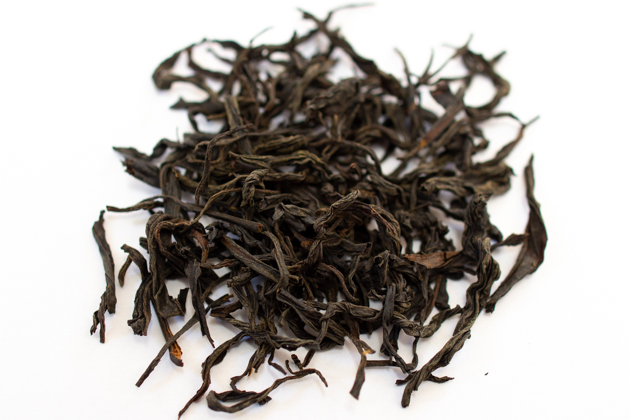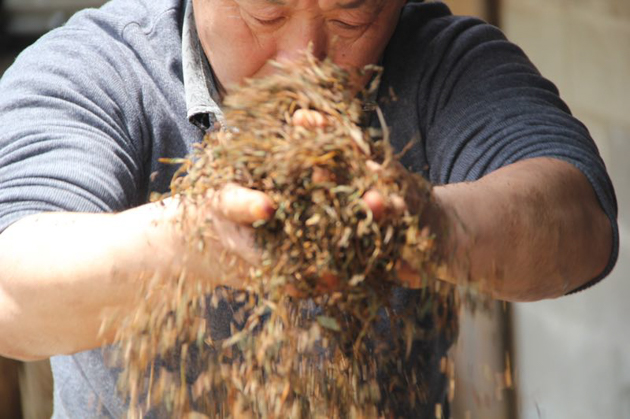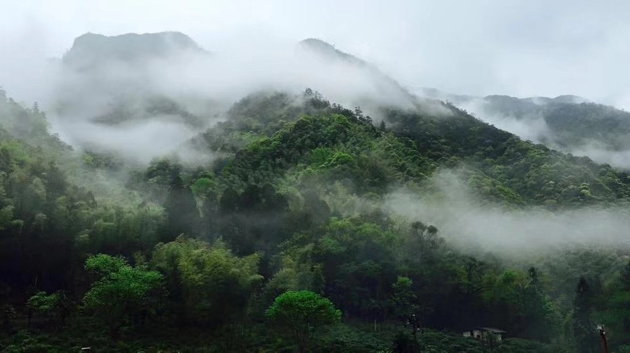- HOME >
- New Arrival at HOJO Online Shop
New Release of Tong Mu Shui Xian Black Tea
- [2020.12.02] Posted By Akira Hojo

We have released very rare black tea, Tong Mu Shui Xian Black Tea.
This tea is from Tong Mu Guan in Wuyishan, Fujian Province, China. The tea garden is located at 1000m above sea level, and the tea garden is totally sustainable, the tea trees are grown without pesticide and fertilizer.
Tong Mu Shui Xian Black Tea is made following the process of Lapsang Souchong
This tea is made from Shui Xian cultivar following the process of traditional Lapsang Souchong 正山小種. Yet, we do not call it Lapsang Souchong. Because the standard of Lapsang Souchong is to use local tea in Tong Mu. The name of Souchong is originally referring to the local seed-grown tea in Tong Mu Guan.
2 Types of Lapsang Shouchong
Currently, there are two types of Lapsang Souchong in Tong Mu Guan.
1.A well-known type of tea which gives a smoky scent.
2.It is a type that gives sweet fruity scent and no smoke scent at all, as represented by teas such as Qi Zhong and Xiao Chi Gan (小赤甘).
Generally, traditional Lapsang Souchong has a smoky scent, and those fruity types are often considered to be the newly develop version of Lapsang Souchong. But I believe in another history.
Lapsang Souchong is also known as the model of Earl Grey tea. It was said that Earl Grey tea originated from the fact that an Englishman who drank Lapsang Souchong in the 1800s was impressed by the tropical fruit-like scent and then later added bergamot flavour to the black tea in an attempt to imitate that scent. If the traditional Lapsang Souchong was smoky, why would not the Earl Grey became smoky type of tea?
Also, in the 1800s, due to the high demand for Lapsang Souchong, Keemun tea was developed following the method of making Lapsang Souchong black tea. If Keemun black tea was made following the process of smoky Lapsang Souchong at that time, Keemun black tea should also be giving smoky scent. However, the standard Keemun black tea is not smoky at all.
These historical stories might not be 100% accurate, but from here we could have imagined that from the 1600s there was fruity version of Lapsang Souchong black tea.
Very Rare Black Tea
Shui Xian is a very famous cultivar of Wuyi oolong tea (rock tea). The popularity of Shui Xian is due to its good taste. It has a strong aftertaste and long-lasting finishing. However, the flavour of Shui Xian cultivar is generally less gorgeous. Only the top-notch skilled tea master is able to manage the process to bring up the flavour. Currently, in Tong Mu Guan, the Shui Xian cultivar is only less than 1% of the total tea production. It is a very rare tea.
Before 1970s, Shui Xian cultivar were grown by many farmers. However, many of trees were removed afterwards.
There were two reasons.
Firstly, there was a professor in Fujian commented that in relatively cooler climate in Tong Mu Guan, the Shui Xian might give weaker aroma.
The second reason was that before year 2000, the black tea was not popular in China domestic market, so the price of tea was low and farmers especially from those remote areas were struggling to make a living. For this reason, many farmers cut down the tea trees and replaced it with more profitable agricultural product, like bamboo, which was used as the raw material for making chopsticks and etc.
Higher level of fermentation
When compare to other types of Lapsang Souchong, like Qi Zhong, the Shui Xian cultivar has larger and thicker tea leaves, so Shui Xian fresh tea leaves are withered in a thinner layer than other teas, and the fermentation is carried out for a longer time.

Charcoal Roasting develops thick fruity flavor
In addition to the general black tea process, Tong Mu Shui Xian and Lapsang Souchong black tea is roasted with charcoal fire.
Process of Tong Mu Shui Xian Black Tea
Fresh Tea leaves → Withering → Rolling → Enzymatic Oxidation → Heating to Stop Enzyme → Drying → Charcoal Roasting
The purpose of charcoal roasting is to intensify the taste of tea. Therefore, the roasting process is carried out at lower temperature for a long time in order to speed up the maturation of tea.
The baking process also brings up the fruitiness in flavour. Once tea is roasted with charcoal, it develops a sweet and rich flavour like dried fruits.
Charcoal roasting is a very tedious work. If the temperature is too high, the tea leaves will be scorched, and if the temperature is too low, the effect is marginal. So, it is necessary to constantly monitor and adjust the temperature.
Some tea producers bake tea with hot air oven. However, once it’s tasted, the outcome is totally different from the tea baked with charcoal fire.
Charcoal fire has strong heat permeability and the heat is transmitted till the centre of tealeaf, whereas hot air does not have a good heat permeability, so only the surface of tealeaf is heated and less heat applied to the inner part.
Thanks to the charcoal roasting process, tea gives a clean and clear drinking sensation, and thick taste lingering on palate that lasts for many brewing.
Related Articles
How to get the latest update on HOJO?
1. Follow Twitter, 2. Click "Like" on Facebook, and 3. Subscribe in newsletter. You can have the latest tea news from HOJO.
 Subscribe the Newsletter to enjoy the privileges
Subscribe the Newsletter to enjoy the privileges- You may receive a free sample upon purchase, or you may have the priority to purchase special products. So please remember to subscribe our newsletter as well as the social network.
- Myanmar White Tea Bud 2013 from Guo Gan, Myanmar
- We have released a raw Pu-erh tea, 緬甸白芽茶 2013 (Myanmar White Tea Bud 2013), produced by ethnic minorities in t …
- Yong De Wild White Tea 2025 Loose Leaf Limited Release
- We have released Yong De Wild White Tea Loose 2025. For the 2025 harvest, only the loose-leaf type was …
NEW ARTICLES
 Myanmar White Tea Bud 2013 from Guo Gan, Myanmar
Myanmar White Tea Bud 2013 from Guo Gan, Myanmar- We have released a raw Pu-erh tea, 緬甸白芽茶 2013 (Myanmar White Tea Bud 2013), produced by ethnic minorities in t …
 Yong De Wild White Tea 2025 Loose Leaf Limited Release
Yong De Wild White Tea 2025 Loose Leaf Limited Release- We have released Yong De Wild White Tea Loose 2025. For the 2025 harvest, only the loose-leaf type was …
 Experience the True Freshness of Raw Pu-erh : Tang Jia 2025 Loose Leaf Release
Experience the True Freshness of Raw Pu-erh : Tang Jia 2025 Loose Leaf Release- We have released Tang Jia Raw Pu-erh Tea 唐家古樹生茶 2025 Loose Leaf. Among HOJO’s raw pu-erh teas, Tang Jia Raw Pu …
 Yunnan Chun Jian Green Tea from High Mountain Gardens
Yunnan Chun Jian Green Tea from High Mountain Gardens- Yunnan Chun Jian Green Tea is now available. This tea is made from naturally grown leaves harvested from high …
 Limited Loose Leaf Release of 2025 Da Xue Shan Wild Raw Pu-erh Tea
Limited Loose Leaf Release of 2025 Da Xue Shan Wild Raw Pu-erh Tea- We have released the 2025 loose-leaf version of Da Xue Shan Wild Raw Pu-erh Tea. This tea comes from wild tea …
 Discover a New Way to Enjoy Tea: Cooking Rice with Tea
Discover a New Way to Enjoy Tea: Cooking Rice with Tea- Cooking rice with tea is a simple idea, but it brings surprisingly satisfying results. The tea’s flavour seeps …
 2025 Da Xue Shan Wild White Tea Now Available from Yunnan
2025 Da Xue Shan Wild White Tea Now Available from Yunnan- The 2025 harvest of Da Xue Shan Wild White Tea is now available. Crafted from truly wild Camellia taliensis tr …
 Fresh 2025 Yunnan White Tea – Select Your Favourite Lot Before Blending
Fresh 2025 Yunnan White Tea – Select Your Favourite Lot Before Blending- Freshly crafted in Yunnan and just arrived in KL, our new 2025 white tea is now available at our Gardens Mall …
 2024 Dong Shan Raw Pu-erh Tea – Crafted with the Producer for Desired Quality
2024 Dong Shan Raw Pu-erh Tea – Crafted with the Producer for Desired Quality- We have released the 2024 cake of Dong Shan Raw Pu-erh Tea. Earlier, we offered the loose-leaf version from th …
 Development of Firewood Roasted Hojicha Using Naturally Grown Tea from Yunnan
Development of Firewood Roasted Hojicha Using Naturally Grown Tea from Yunnan- We are currently staying in Yunnan Province for tea production. As the season nears its end, tea trees with pa …
Category
- New Arrival at HOJO Online Shop
- Featured Articles
- Newsletter
- Types of Tea
- Origin of Tea
- Teapot and Tea Equipment
- Tea Column
- How to enjoy tea
- Tea Processing
- How to choose quality tea
- Tea constituents and functional effect
- Safety of Tea
- Foods
- Tea Business Operation
- Hobby and Outdoor Activity
- Ranking of Tea
- Video
- FAQ
- Media Release
Profile

- AKIRA HOJO
- I invite you to experience my tea selections.I was born in Nagano, Japan. In university, I studied agricultural chemistry, and I have the master degree in food science. I worked in Japanese food industry for 10 years. I involved in R&D, QC and QA. As a factory manager, I implemented ISO9000 series and managed the factory.
- The Art of Tea Magazine
- We posted the article on “The Art of Tea Magazine No.9, the magazine is published in Taiwan. We featured …
- New Straits Times
- The Malaysian National Newspaper, New Straits Times featured HOJO Tea on 17-Oct-2007.
Shop Info

Address:Lot No. T-215, 3rd Floor, The Gardens Mall, Mid Valley City, Lingkaran Syed Putra, 59200 Kuala Lumpur
Tel: +603-2287-4537
Business Hour: 10am to 10pm

















